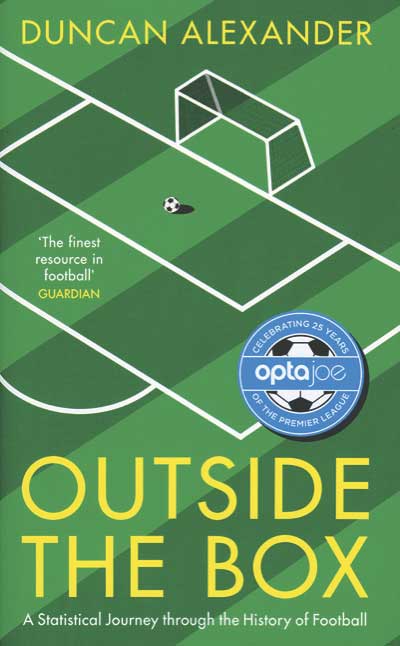
by Duncan Alexander
Cornerstone, £16.99
Reviewed by Gordon Cairns
From WSC 369, November 2017
Buy the book
Imagine a book, the bulk of which consists of 25 Season in Briefs; all of the same competition with the same names reappearing with grim regularity at either end of the table. Reading about so many Premier League titles back-to-back can get a little wearing, especially as the intended audience will presumably know the outcome. The hook of Outside The Box is that these titles are examined through their numbers. Again, it would be impossible to write about football without using them – every aspect of the game has a number attached, even describing the shape, 3-5-2 compared to the 4-4-2 is illustrated numerically.
However, Opta data editor Duncan Alexander can still pull out meaningful stats from familiar material, such as David Moyes’ reign in Manchester. At home to Fulham, his side made 81 crosses without success, the highest in a Premier League game analysed by Opta, while he never kept the same line-up in his 51 matches in control at Old Trafford – two numbers which partially explain his subsequent fall from grace as a well-regarded manager.
Pub quiz masters everywhere will be kept in football questions for decades; who was the last team wearing stripes to finish in the top four of the Premier League? (Newcastle United in 2003.) What record does Joe Hart currently hold? (He is the keeper who has taken most throw-ins over the past ten seasons with four.) While the book is heavy on numerical facts it is light on analysis, apart from a chapter on how an imaginary manager’s tactical approach to an FA Cup clash is influenced by statistics. He discourages players on pain of a fine from shooting outside the box as there is only a three per cent success rate compared to 14 per cent inside the penalty area. And aware that a penalty is less likely to be scored by the player who won it, he chooses another to take a penalty.
Another chapter challenges the commonly held view that the second part of Arsène Wenger’s career at Arsenal has been one of decline when his win average before and after 2006 has been rather stable, 0.1 per cent the difference between each period. It’s just that the world outside has changed with the arrival of José Mourinho, Sheikh Mansour and the rejuvenation of Spurs changing the two-horse nature of the early years of the league.
Only a year after the publication of Opta Joe’s Football Yearbook 2016, there is a sense that there is not enough material for another opus of over 300 pages. Statistics reappear in different chapters and we are treated to a bizarre section on Lionel Messi. Alexander imagines a factory in Denmark printing Messi calendars where each month argues over which one produced the most fascinating stats of Messi’s career.
Equally oddly, the book ends on a sort of football version of London Orbital, where the author takes a bike ride around the Midlands’ stadiums where journeyman striker Trevor Benjamin played and which encircled his birth place of Kettering. Like Alexander’s cycling, this book trundles slowly to the end.